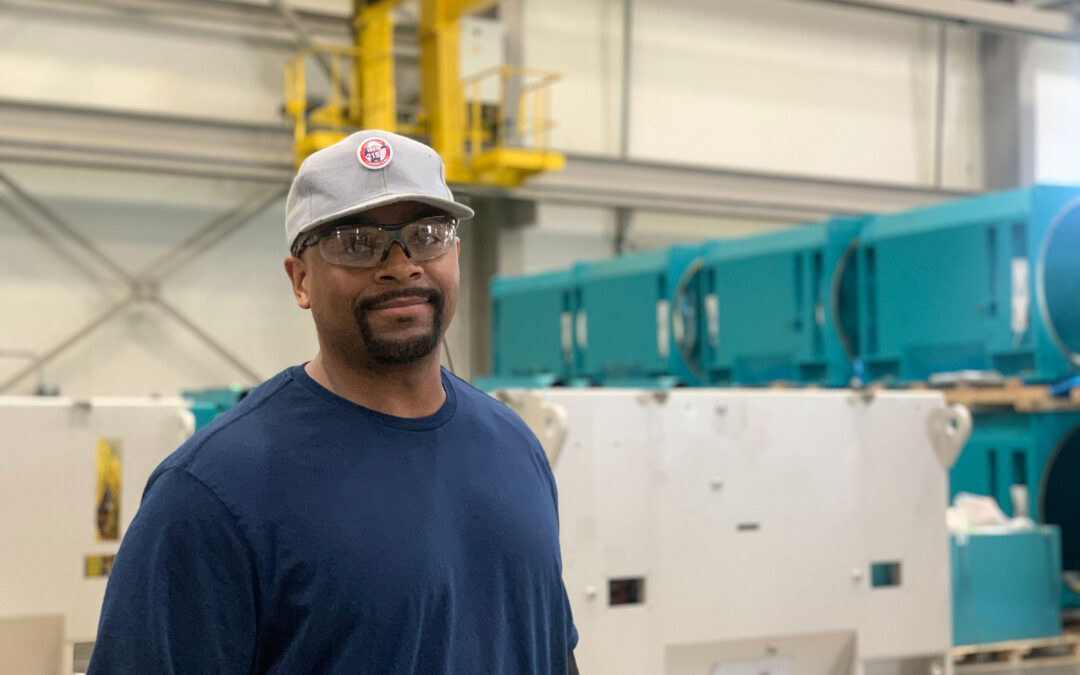
by Jodi Jean Amble | May 17, 2022 | Advocacy, Community, Electric Vehicles, Jobs, Local Initiatives, Renewables, Solar, Wind
RENEW Wisconsin has launched two state-wide communications campaigns to promote the benefits of clean energy investments in Wisconsin. The two campaigns, “Clean Energy Works for Wisconsin” and “Clean Energy is Made in Wisconsin,” include print and digital ads and shareable communications assets for partners and clean energy advocates.
Wisconsin’s clean energy workforce is 70,000 strong, with good-paying local jobs like installing solar and electric vehicle charging stations, manufacturing energy storage systems, servicing wind turbines, and retrofitting buildings. Clean energy job growth is gaining momentum from state and federal clean energy and electric transportation commitments, federal funds to support these goals, and an increased interest in clean energy investments from the public sector. The “Clean Energy Works for Wisconsin” campaign highlights the job potential of continued investment in electric transportation and Wisconsin clean energy.
“Over the next five years, Wisconsin can expect to receive $79 million in federal funds from the bipartisan infrastructure law,” said Francisco Sayu, Emerging Technologies Director at RENEW Wisconsin. “Wisconsin will also have the opportunity to apply for $2.5 billion in competitive grant funding dedicated to electric vehicle corridors and community charging. Building a network of electric vehicle charging stations will reduce emissions, improve air quality, and create thousands of good-paying jobs and is a tremendous opportunity for Wisconsin residents.”
In 2019, Governor Evers set a goal that all electricity consumed in the state will be 100% carbon-free by 2050, and in 2022 introduced Wisconsin’s first-ever Clean Energy Plan. Currently, renewable energy only accounts for 13% of all electricity sold in Wisconsin. According to the U.S. Energy Information Administration, Wisconsin consumes almost six times as much energy as it produces and spends billions on coal, oil, and natural gas every year. The “Clean Energy is Made in Wisconsin” campaign presents a vision of keeping more energy dollars in-state by investing in homegrown renewable energy.
“State and federal investments are moving us toward our clean energy goals, but we need to maximize the benefits of this energy transition for Wisconsin residents,” said Heather Allen, Executive Director at RENEW Wisconsin. “We will need an ‘all of the above’ and ‘all hands on deck’ approach to shape our clean energy future. This means smart investments in homegrown renewable energy and clean transportation.”
Print and digital ads are already circulating in media outlets across the state. To learn more and help amplify Wisconsin’s clean energy opportunities, please visit the “Clean Energy Works for Wisconsin” and “Clean Energy is Made in Wisconsin” landing pages.
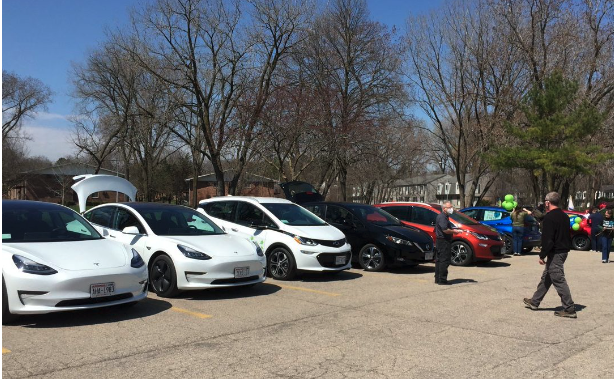
by Francisco Sayu | Apr 11, 2022 | Community, Electric Vehicles, Events, Local Initiatives
On Friday, April 22, 2022, Drive Electric Wisconsin, RENEW Wisconsin, Slipstream, Wisconsin Clean Cities and the Dane County Office of Energy and Climate Change will be hosting an Earth Day Electric Vehicle (EV) Parade in Madison.
A variety of electric vehicles will converge at Demetral Park at 1:00 pm. The parade will depart the park at 2 pm, drive through downtown, make two loops around Capitol Square, and return to Demetral Park. Spectators are encouraged to attend at Demetral Park, Capitol Square, or along the parade route.
All battery electric vehicles (BEVs), plug-in hybrid electric vehicles (PHEVs), electric trucks, and electric motorcycles are welcome to join the parade. For more information and registering for the event, please visit Earth Day EV Parade.
In the Wisconsin transportation sector, GHG emissions are the second-largest source of emissions; EVs currently present the most substantial potential to significantly reduce GHG emissions in the transportation sector, primarily when electricity is generated with low-carbon resources. EVs provide many benefits, including lower maintenance costs, lower fuel costs, zero local emissions, quieter operation, and faster acceleration. As Wisconsin continues to transition to clean energy, the environmental benefits of “driving electric” will continue to increase.
Local residents Carol and Andy Phelps organized Madison’s first Earth Day EV Parade in 2020 as a way to celebrate EVs and Earth Day amid the pandemic. In 2021, more than sixty vehicles joined, RENEW Wisconsin, Slipstream and Dane County Office of Energy and Climate Change for the second Earth Day EV Parade. Many EVs and electric motorcycles are expected at this year’s parade, including Ford, Volkswagen, GM, Tesla, Nissan, Hyundai, Kia, Toyota, Audi, Porsche, BMW, Mercedes-Benz, and Harley Davidson.
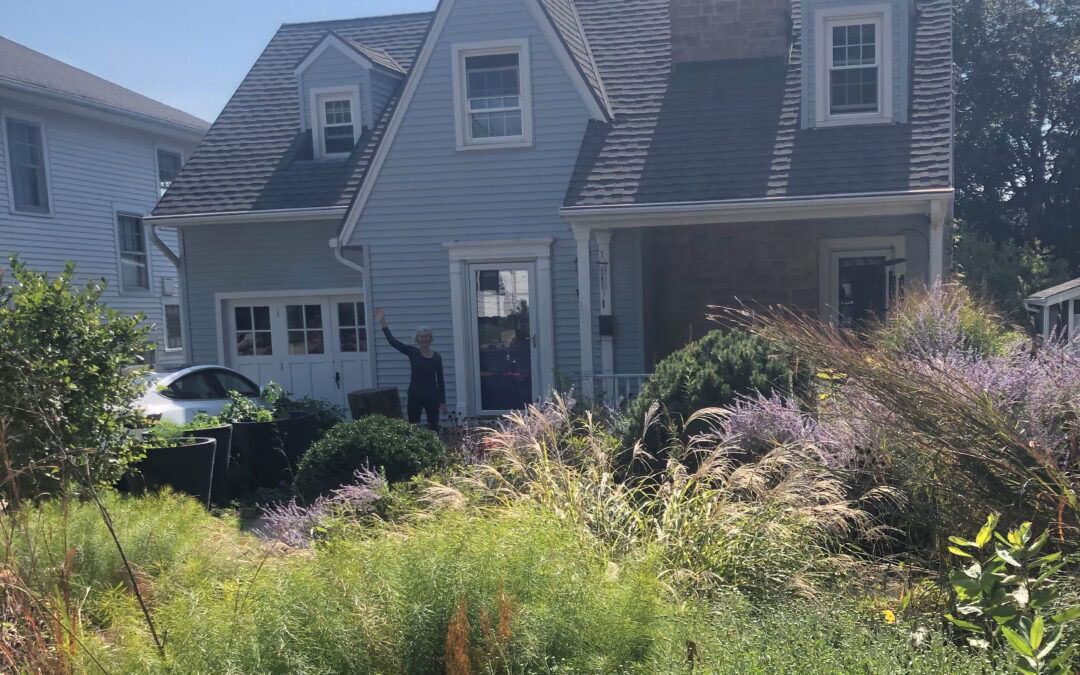
by Guest Blog | Nov 24, 2021 | Community, Focus on Energy, Home, Renewables, Solar, Sustainability
Beneficial electrification discussions often revolve around transportation electrification, specifically how electrifying vehicles can reduce emissions and offer cost savings for consumers. However, an under-discussed and equally important part of beneficial electrification is the building sector. At 24% direct emissions, the building sector comprises the largest end-use emissions in Wisconsin. Read further to learn about Susan Millar’s journey towards electrifying her home, including her installation of an air-source heat pump for greater heating and cooling energy efficiency.
The companies, technologies, and programs endorsed in this blog are not necessarily recommended or endorsed by RENEW Wisconsin. The following information and personal experience is illustrative of the process to electrify a residential property in Wisconsin.
Are you wondering how to convert an older single-family home with a forced hot-air heating system, a gas water heater, and a gas stovetop from gas and electric to electric-only? I have done that with a 90-year old house on the near west side of Madison. And because it took a fair amount of time, I am sharing the process I used. Before describing this process, I provide important context.
Context for Transitioning to All-Electric
- “Natural” gas is fossil gas. It must, and will, be phased out over time as our society gets more serious about reducing climate-warming emissions. In some municipalities, bans on gas in new construction are already in place.
- Air source heat pumps (ASHPs) are the energy-efficient electric-powered alternative to gas heating systems. ASHPs both heat and cool your house (no separate AC device needed). They have a high coefficient of performance, so while they use electricity, the amount is much less than, say, what an electric space heater or traditional AC unit uses. See, for example, this video description of ASHPs.
- Air source water heaters (also called “hybrid” water heaters) work the same way as ASHPs except they exchange air with your basement instead of the air outside. They are far more efficient than traditional electric water heaters.
- Our state’s Focus on Energy program provides rebates for air-source air and water handling systems. The installers handle this process. (I am not sure of the size of these rebates.)
- MG&E’s monthly (gas) service charge is $22. If you stop your gas service and start it again, they will bill you for monthly service charges for up to 12 months prior to the time you start again. That is, you cannot stop your gas service except for, say, the month of January without paying for up to 12 months of service.
- If you have not yet, or cannot install, solar panels on your roof, you can sign up for MGE’s shared solar program.
- If you have an EV and are willing to charge it and also run your dishwasher, etc during MG&E’s low-rate (off-peak) period (from 9 pm to 10 am on weekdays, and during weekends and holidays), you can substantially reduce your electricity bill. To do this, call MG&E and ask them to add you to their ‘Time Of Use’ program.
- Yes, you have to lay out money ahead of time to transition from gas, and I am aware that many people cannot do this. The financial payoff comes over time. For example, while paying both gas and electric service charges, and charging my EV at home, my MG&E bill this summer was between $20 -30 per month. This is largely due to having rooftop solar and Time Of Use electricity rates. While my utility bills will be higher this winter, they will be reduced by the $22 monthly gas service charge and will be substantially less than prior winters. For me, another major advantage is that I am emitting essentially no carbon dioxide to run my home and car.
Steps for Transitioning to All-Electric (used by an early adopter)
- Get an energy efficiency analysis. This is very important because if you switch from a furnace powered by an unlimited amount of gas to an ASHP, it’s important that your house holds its temperature (in winter or summer) as effectively as possible. I used a local energy efficiency consultant. He did a superb job.
- Improve your insulation. If your energy efficiency analysis indicates that your house needs insulation, then arrange to get it. I used a small local company that treated my home as if it was their own. I felt the difference immediately, even in summer.
- Replace your gas stovetop (both to get off of gas and because much new research indicates respiratory health problems are caused by gas stovetops). As I have a unit with an electric oven and gas stove, I purchased two Cuisinart’s Double Induction Cooktops (not expensive), which I placed over the gas burner area on my stove and just plugged in. (Induction stovetops work great, and are much easier to keep clean.)
- While doing steps 1 & 2, get contracts with the HVAC and plumbing company you will use. I started with the local HVAC company that I was used to. They proposed an ASHP system that would heat my house to +14F degrees and required that I retain my gas furnace for backup in the winter. As I want to eliminate the year-round monthly gas service charge, I turned them down. I tried 3 other local companies. Same response. I looked wider and found a company located near Milwaukee. In light of the energy efficiency and size of my house, they proposed to replace my gas furnace and AC units with a Mitsubishi P system that will efficiently heat my house to -14F, and then shift to an electric element (low efficiency) backup system for super cold snaps. Their price? Same as the local HVAC folks who proposed installing a +14F system with gas back-up. I accepted Midwest’s proposal. Moreover, they agreed to install my (still effective and efficient) gas and AC units in the home of a friend who has very inefficient HVAC systems – so the embedded carbon in those devices is not immediately trashed. (FYI, I informed the local HVAC companies of my decision – they lost my business to a more cutting-edge, non-local competitor.)
- Meanwhile, after checking different local plumbers, most of whom do not install hybrid water heaters, I found a small local plumbing company that proposed to install one of these at a very decent price. I happily accepted his bid.
- Both the HVAC and plumbing companies I signed with encountered installation delays because ASAP and hybrid water heater manufacturers are having sourcing issues. These problems are either due to Covid shipping issues or because the manufacturers are sending their stock to states that are ahead of us on installing these systems. Demand pushes the market.
- Both the hybrid water heater and the ASHP have easy controls and work superbly. For the mid-October to mid-November billing period, the first during which I used electricity to heat water, heat the house, and charge my EV, I used 664 kWh. My MG&E bill was $54. In round numbers, they charged me $42 for connection and distribution services, $15 for contributions to their Shared Solar, Green Power, and Low-Income Assistance programs, and $37 for electricity used at variable rates. (I have “Time of Use.” Most of my use was at the very lowest rate.) They credited me $39 for “net energy exported at variable rates” (kWhs from my solar panels), and $2 for “fuel cost.” All that suggests that I paid $-2 for electricity provided by MG&E.
- If you would like cost or contact information for the energy efficiency, insulation, HVAC, plumbing, and electrician contractors I used, just email me at sbmillar@gmail.com.
Susan Millar, September 2021

by Andrew Kell | Nov 10, 2021 | Advocacy, Community, Focus on Energy, Local Government, Policy, PSC Priorities, Public Service Commission
In 2019, Governor Evers issued Executive Order #38 to establish a goal for carbon-free electricity in Wisconsin by 2050. As the state regulator of utilities, the Public Service Commission (PSC) is tasked with regulating the number one sector source for greenhouse gas emissions in Wisconsin[1]. As a result, PSC decisions play a key role in determining whether Wisconsin will be able to achieve a zero-carbon grid by 2050.
The PSC reviews utility proposals for construction projects, rate increases, and new utility programs for their customers. However, the PSC reviews these proposals separately from one another, and historically without the integration of other utility plans, carbon reduction goals, and cross-sector emission-reduction strategies. The good news is that the PSC has begun to explore how to incorporate these factors within its decision-making processes going forward.
In keeping with a recent trend of investigating policy issues (such as Electric Vehicles and Parallel Generation), this past spring the PSC opened a docket (5-EI-158) to pursue a “Roadmap to Zero Carbon.” As described in the Notice of Investigation, the PSC intends to evaluate government and utility goals to reduce carbon emissions to zero by 2050, recommendations from recent Wisconsin reports on clean energy and climate change, and the development of partnerships to achieve carbon-free electricity by 2050.
The Zero Carbon Roadmap docket garnered much interest from active PSC intervenors (such as RENEW), with participation from environmental, health, and business advocates as well. Members of the general public also participated with input and suggestions. PSC staff issued a memo for public comment on scoping of priorities. After gathering public input, PSC staff issued a follow-up memo to the Commissioners in August that summarized stakeholder input and provided the Commissioners with options on the next steps. The Commissioners then discussed the memo and issued an order in September to take some initial actions.
In short, the PSC decided to leverage ongoing planning processes and to investigate a potentially new approach to utility ratemaking. Below is a summary of these initial steps:
- The PSC will gather more robust carbon-reduction planning information from utilities during the current biennial Strategic Energy Assessment (SEA). Utilities will soon respond to the PSC staff’s initial data request, and PSC staff will issue a draft report by next spring for public comment;
- Additionally, the PSC will seek public input on ways in which the state’s Focus on Energy program (Focus) can better incorporate beneficial electrification, programs for low-income customers, demand response, and other utility voluntary programs into its program design over the next four years. This is called the Quadrennial Planning Process, and a PSC staff recently issued a memo for comment on scope; and
- Finally, the PSC will organize a workshop on Performance-based Regulation (PBR). This workshop will gather information and perspectives on how rethinking utility goals and investment incentives can lead to a more equitable clean-energy future. The PSC will also consider customer affordability issues in relation to the transition to a zero-carbon grid.
Even with these planning processes already underway, the book is not closed on the Roadmap to Zero Carbon docket. RENEW recently reached out to Joe Fontaine, PSC Policy Advisor, to get a better sense of next steps for the investigation docket itself. Fontaine said:
“Commission staff is excited to kick off the Roadmap by addressing four of the highest priorities identified by commenters and approved by the Commission. Each of these four areas — more transparent resource planning, development of performance-based regulation concepts, and further analysis of affordability and energy efficiency issues — can help us develop a strong general foundation to address a wider range of issues related to the clean energy transition, in this investigation as well as in other Commission dockets. Future decisions in the Roadmap will be well-informed by the analysis and stakeholder input we’re receiving at each step in the investigation. Potential next steps will be determined as we make progress on these initial priorities over the next few months.”
The PSC’s Roadmap to Zero Carbon activities is running in parallel with the Office of Sustainability and Clean Energy’s (OSCE) Clean Energy Plan drafting process. Beyond the electricity sector, the Clean Energy Plan will assess, and make recommendations on, strategies cutting across all economic sectors statewide. The OSCE recently gathered public input during several public listening sessions, focusing on 1) economic and environmental justice, 2) infrastructure and industry, 3) transit and transportation, and 4) clean energy and energy efficiency. The OSCE continues to gather written comments through its website.
RENEW is also proactively partnering with Clean Wisconsin and GridLab to conduct a zero-carbon grid study for the PSC’s consideration. While the scope is still being finalized, the study will use modeling designed to answer important policy questions, such as:
- What is the right mix of renewable resources in-state and out-of-state?
- What is a good balance between utility-scale and distributed solar resources?
- How much transmission is needed in a zero-carbon future?
- What will be the health, jobs, and economic impacts as we make this clean grid transition?
Stay tuned on these zero-carbon planning activities and upcoming study developments. RENEW plans to organize presentations and panel discussions on these topics at our Renewable Energy Summit on January 27, 2022.
[1] See the Department of Natural Resources’ Wisconsin Greenhouse Gas Emissions Inventory Report of August 2020. Figure 1, on page 3, presents emissions by sector. Electricity generation is the highest emitting sector and represents 33 percent of all Wisconsin emissions.
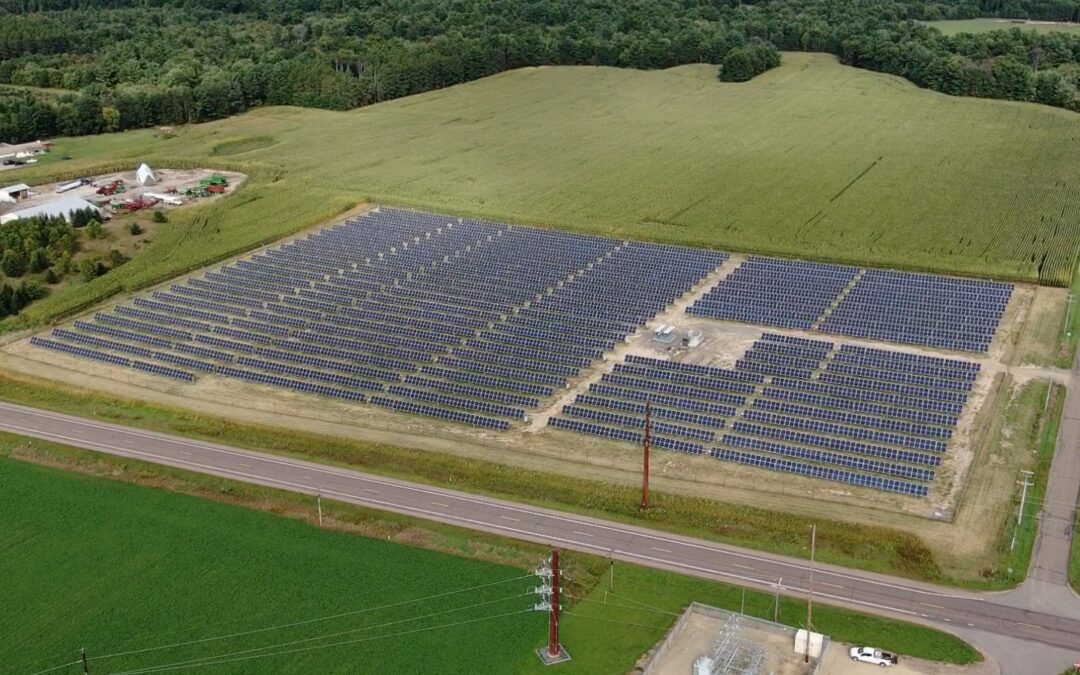
by Michael Vickerman | Oct 27, 2021 | Advocacy, Community, Community Solar, Local Government, Policy, RENEW Wisconsin, Renewables, Solar, Sustainability
For decades, utility investments in power plants and transmission lines have been predicated on the concept of economies of scale. The theory behind it is beguilingly simple: the larger the installation sought by an electric utility, the lower the unit cost of the investment, which utility planners and regulators regard as a measure of economic efficiency. When loads are growing, the “bigger is better” paradigm is often an economically rational fit for electric utilities seeking to recover large-scale capital investments in fossil generation over the broadest possible cohort of current and future customers.
But solar power, the default resource option for electric providers today, is a somewhat different animal due to its scalability. Yes, economies of scale can certainly reduce the unit price of solar generating capacity, but other on-the-ground factors can influence the economics of this resource. These factors include but are not limited to the cost of acquiring site control of the host properties and obtaining all the necessary approvals to construct the project. Interconnection costs can be high as well, especially for larger projects requiring additional land and approvals to supply power to the grid.
These thoughts came to mind after visiting two smaller solar farms that started producing power this year. The first project, called Strobus Solar, was developed by OneEnergy Renewables and serves Jackson Electric Cooperative. The second installation, O’Brien Solar Fields, was one of the stops in this September’s Ride with RENEW bicycle tour. Developed by EDF Renewables and owned by Madison Gas and Electric (MGE), this 20 MW solar farm in Fitchburg supplies electricity to seven MGE customers under long-term contracts.
At a Glance
Solar For the Distribution Grid – 2021 |
| Project name |
Strobus Solar |
O’Brien Solar |
| County of location |
Jackson |
Dane |
| Capacity (in MWac) |
1.5 |
20 |
| Project developer |
OneEnergy Renewables |
EDF Renewables |
| Project owner |
Greenbacker Capital |
Madison Gas + Electric |
| Utility territory |
Jackson Electric |
Madison Gas + Electric |
| General contractor |
Arch Electric |
Boldt Construction |
| Landowner |
Northern Family Farms |
O’Brien Brothers Farm |
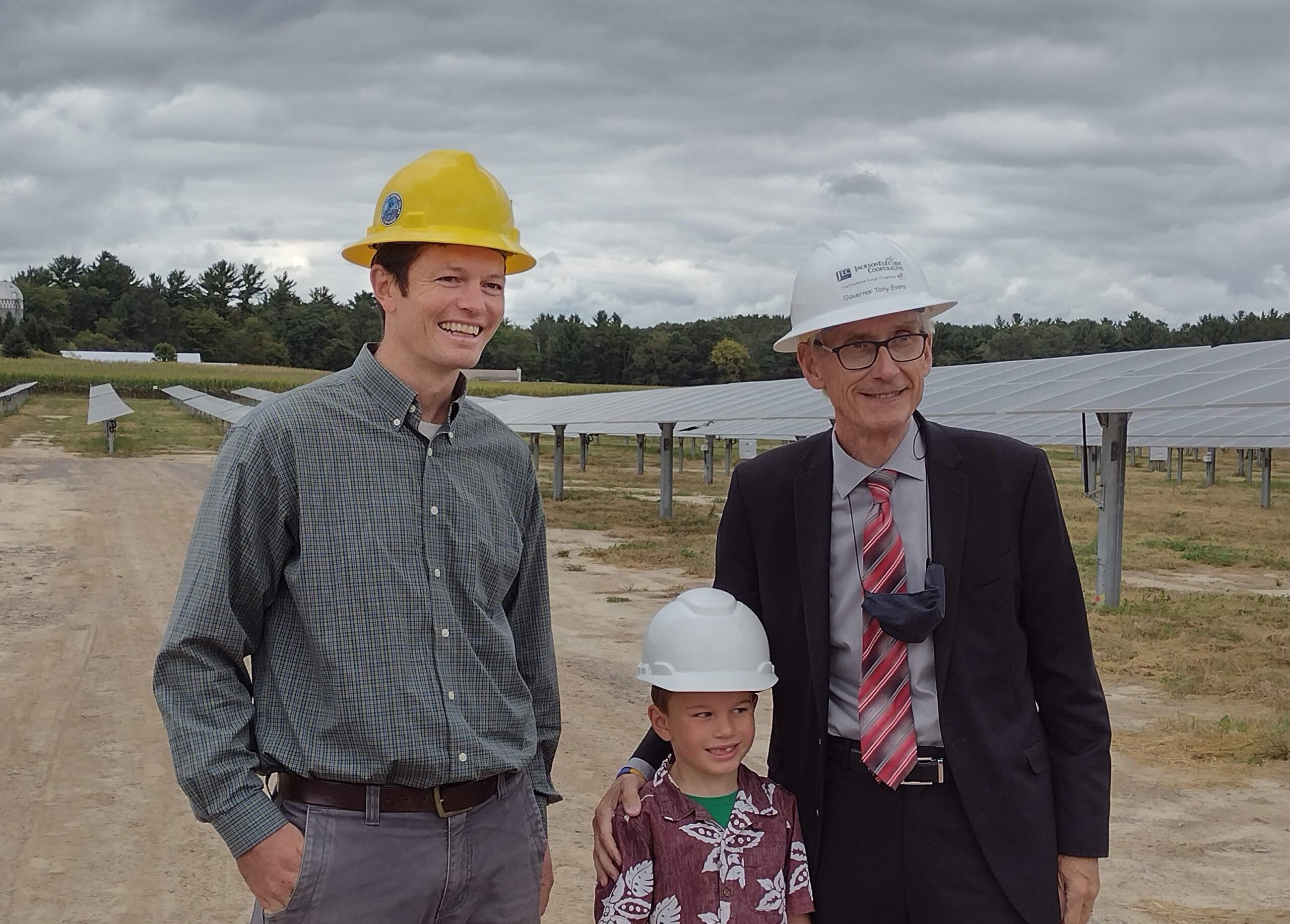 Governor Evers and the Project Developer, Eric Udelhofen, from OneEnergy Renewables at the Ribbon Cutting Ceremony for the Strobus Solar project.
Governor Evers and the Project Developer, Eric Udelhofen, from OneEnergy Renewables at the Ribbon Cutting Ceremony for the Strobus Solar project.
Strobus – A Mastodon Solar project
Occupying a mere 12 acres, Strobus Solar is located about six miles north of Black River Falls and is tucked into a compact parcel framed by evergreen trees and U.S. Highway 12. On a cloudy September day, more than 50 people attended a ribbon-cutting ceremony for the Strobus project, one of eight solar farms in southeast Minnesota and west-central Wisconsin that make up OneEnergy’s Mastodon Solar portfolio. With a combined 17 megawatts (MW) of AC-rated capacity, all eight Mastodon solar farms are located in the territory served by rural electric cooperatives.
As noted on OneEnergy’s website, “the electricity generated by each project will be purchased by the local participating electric cooperative, resulting in savings on energy supply and increased resiliency. These savings will be passed onto the cooperative’s members. The available Renewable Energy Credits will then be sold separately to visionary buyers committed to ensuring their renewable energy procurement dollars are devoted to new projects that serve local communities.”
Of the four Mastodon projects located in Wisconsin, Strobus is the second to be energized this year, following Blue Prairie, a 2.5 MW installation southwest of Black River Falls. The other two, Stromland and Shamrock, should be operating before the end of this year. Plymouth-based Arch Electric is the general contractor for all four Wisconsin projects.
Governor Evers spoke at the ribbon-cutting ceremony, along with representatives of Jackson Electric Cooperative, Arch Electric, and Northern Family Farms, the participating landowner. Based in nearby Merillan, Northern is Wisconsin’s largest Christmas tree grower, operating on more than 7,000 acres. After the prepared remarks, OneEnergy and Arch opened the gates to let Governor Evers and other guests circulate through the project and ask questions.
On one corner of the Strobus parcel is the substation that feeds the solar-generated electricity directly into the wires overhead. Though the equipment onsite is brand-new, low-growing grassy vegetation has already been established, covering the entire project footprint. After three years, the mix of deep-rooted, primarily native plants will provide a healthy habitat for birds, insects, and other species. At nearby Blue Prairie, sheep are already grazing around and under the 7,000 panels installed there.
Strobus is expected to generate about 3,000 megawatt-hours of electricity a year. But the Renewable Energy Credits associated with that output will not flow to Jackson Electric. They will instead be sold to Native, a Public Benefits Corporation, through its New Renewables Portfolio.
According to Native’s website, the purpose of the Portfolio “is to enable Renewable Energy Credit (REC) buyers to play a causal role in actualizing new renewable energy projects. Native has committed to a 10-year renewables purchase agreement with Strobus, LLC on behalf of Portfolio investors. Without this type of long-term REC purchasing agreement, this project would not be economically viable.”
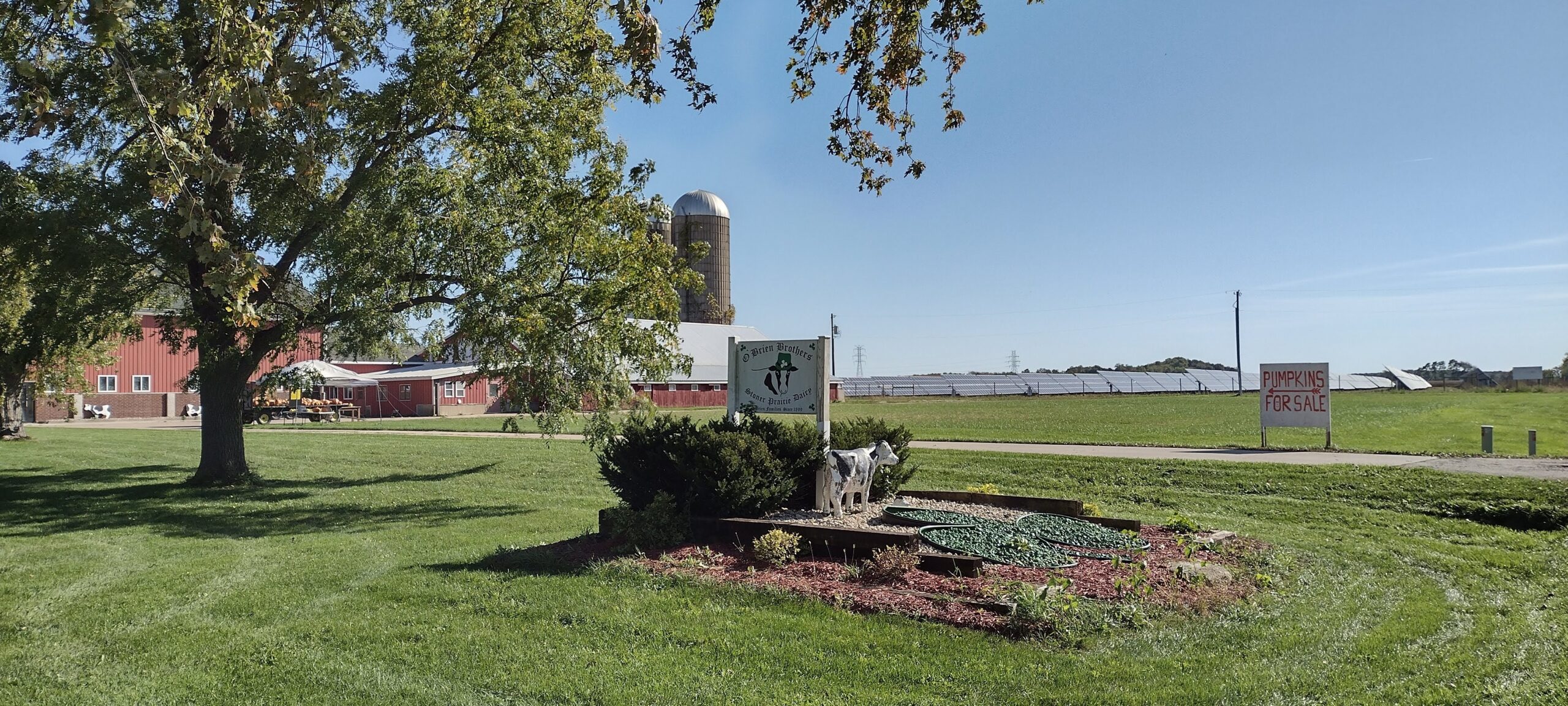 O’Brien Solar Fields in the city of Fitchburg, Wisconsin.
O’Brien Solar Fields in the city of Fitchburg, Wisconsin.
O’Brien Solar – Clean Energy Produced Offsite for Larger Customers
Occupying 130 acres along the edge of urban Fitchburg, O’Brien Solar Fields is as large as a distributed solar project gets. However, while every kilowatt-hour produced at O’Brien flows directly into Madison Gas and Electric’s distribution grid, only seven customers see the impact of this project on their utility bills. Those customers are the State of Wisconsin, University of Wisconsin-Madison, City of Fitchburg, Promega, Placon, Tribe 9 Foods, and Willy St. Co-op.
Energized this summer, O’Brien Solar is the newest Renewable Energy Rider (RER) project serving MGE customers. Several years ago, MGE received approval from the Public Service Commission (PSC) to build solar farms to serve individual customers, including those with multiple facilities, through its RER program. Unique to MGE, this service allows customers to be served by one larger solar farm instead of building numerous solar systems to supply each of their facilities.
A voluntary program, MGE’s RER program does not affect base electric rates. Participating customers fully absorb the cost of MGE’s investment in the solar arrays, and these costs are spread over 30 years. The electricity generated at O’Brien offsets grid power that would otherwise flow to these customers at specified prices throughout the contract term. Should standard electric rates rise faster than the agreed-upon pricing for O’Brien’s electricity, the savings will flow directly to the participating customers.
This unique model combines elements of both behind-the-meter generation and community solar power. But in order to entice customers to access brand-new yet low-cost sources of power, the project owner must design and develop projects that are competitive with the utility’s own avoided cost of power.
The question arises, what did MGE do to keep O’Brien’s development costs in line with its investments in larger solar projects and make it an affordable option for customers?
First, the project occupies only one parcel of land, the former Stoner Prairie Dairy owned and operated by the O’Brien brothers over several generations. Though the parcel is adjacent to a rapidly growing neighborhood, the project’s configuration allows the O’Brien family to maintain its most profitable farming operations as well as live in their long-time residence. Negotiating with only one landowner gives a developer more room in tailoring the project to avoid potentially expensive workarounds.
Second, from an electrical perspective, the project is divided into three zones, each with a separate interconnection to MGE’s feeder lines. By spreading out the project’s output in this fashion, MGE could forgo the more significant expense of running a large tie-in line to the closest substation.
Third, much like a 30-year residential mortgage, the RER contract is a powerful tool for breaking down a significant capital outlay into a manageable expense for the customer. Just as utilities rely on extended depreciation schedules to help them digest the costs of building central station power plants, the RER service provides a similar benefit to participating customers.
In the end, the all-in cost of O’Brien Solar Fields amounted to $29.5 million, which, on a unit basis, comes to $1,475 per kilowatt (kW). To put that number in perspective, the unit price of six larger solar farms totaling 414 MW that Alliant Energy proposes to acquire is $1,449 per kW. In fact, O’Brien’s unit cost is within 10% of the estimated cost of acquiring a 20 MW share of a project ten times as large.
Moreover, it took only three years for EDF Renewables, O’Brien’s original developer, and MGE to advance this power plant from the concept stage to fruition, a relatively speedy turnaround compared with larger solar installations.
Conclusion: The Policy Case for Smaller Solar Farms
Indeed, small solar farms can deliver affordable electricity at a reasonable price by avoiding the increased complexities and additional permitting hurdles associated with larger solar farms that tie into the transmission system. Moreover, while larger solar farms make a great deal of sense in areas rich in transmission infrastructure, relying solely on those locations would exclude much of Wisconsin from being able to host solar power.
There are many parcels of land throughout Wisconsin that have the requisite attributes for hosting projects on the scale of Strobus and O’Brien. In addition, projects of that size are ideal vehicles for community solar offerings, designed to deliver zero-carbon electricity to subscribing customers who cannot access solar power at their residence or business.
Over time, with increases in system power costs looking very likely, the state should explore and adopt policies to promote smaller solar farms within its boundaries. As exemplified by the Strobus and O’Brien projects, development on that scale can yield faster results at comparable costs while potentially providing a reliable revenue stream to the many thousands of landowners who don’t live near high-capacity transmission lines and substations.
Wisconsin is in the beginning stages of an energy revolution. With a more forward-looking policy framework, Wisconsin could emerge as a national leader in solar power. Embracing distribution-level solar solutions now will help more Wisconsinites participate in the benefits of these projects and give every city, town, and village a solar project to call their own. Wisconsin’s population is distributed throughout the state–our renewable energy portfolio should be as well.
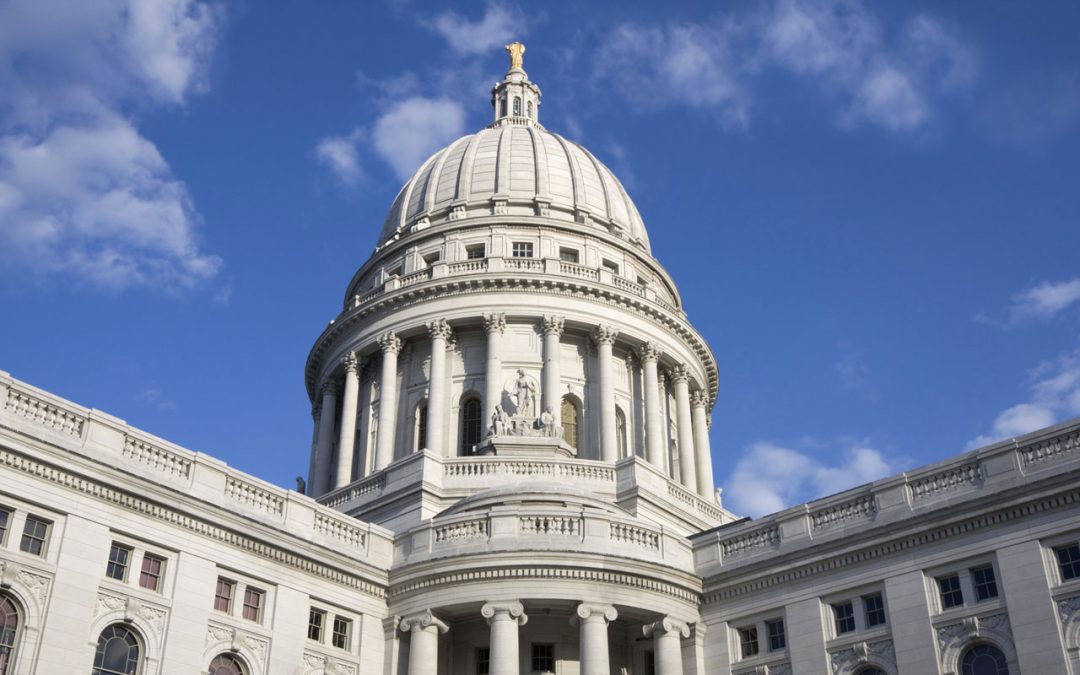
by RENEW Wisconsin | Oct 26, 2021 | Advocacy, Community, Community Solar, Electric Vehicles, Events, Home, Jobs, Legislative Watchlist, Local Government, Policy, RENEW Wisconsin, Renewables, Solar, Sustainability
On October 13, RENEW Wisconsin and Wisconsin Conservative Energy Forum (WCEF) hosted their first-ever Renewable Energy Day at the Capitol in Madison. The event included issue briefings by industry experts on a variety of legislation that has been introduced this year related to the solar and electric vehicle industries. Attendees then went to the State Capitol to speak with their legislators to gain support for these important issues.
During a welcome reception, the evening before the Day at the Capitol, RENEW and WCEF held a panel discussion “Energy in Transition: Policy and Politics.”
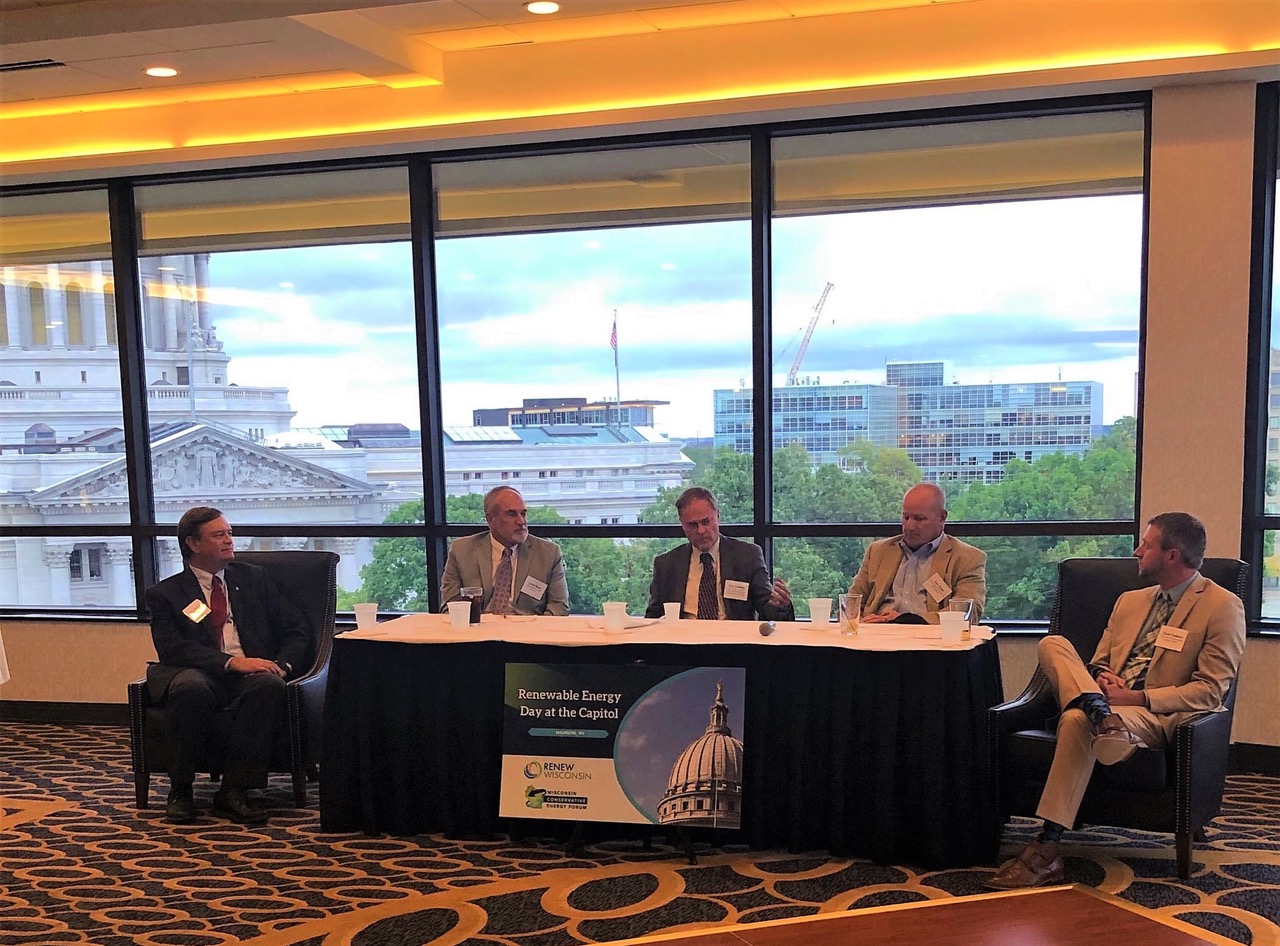
From right to left were moderator, Scott Coenen (WCEF), Dan Ebert (former PSC Chairman), Senator Rob Cowles, Larry Ward (Conservative Energy Network), and Jim Boullion (RENEW Wisconsin).
The panel discussed the current uncertainty in world energy markets and the impact that energy shortages and spiking prices will have on the world. There was consensus from the conversation that panelists believe renewables can help stabilize much of this energy uncertainty, but that the industry needs to be realistic about its role in a world where supply is not meeting demand. Businesses, households, and communities in Wisconsin should be empowered to invest in their own energy generation.
Before attendees went to the Capitol to meet with their legislators, there was an issue briefing with a panel of industry experts moderated by Jim Boullion, Director of Government Affairs for RENEW Wisconsin. The panelists explained in detail what legislative proposals were currently before the legislature, how they will impact renewable energy in Wisconsin, and what arguments are being made on both sides of the issue.
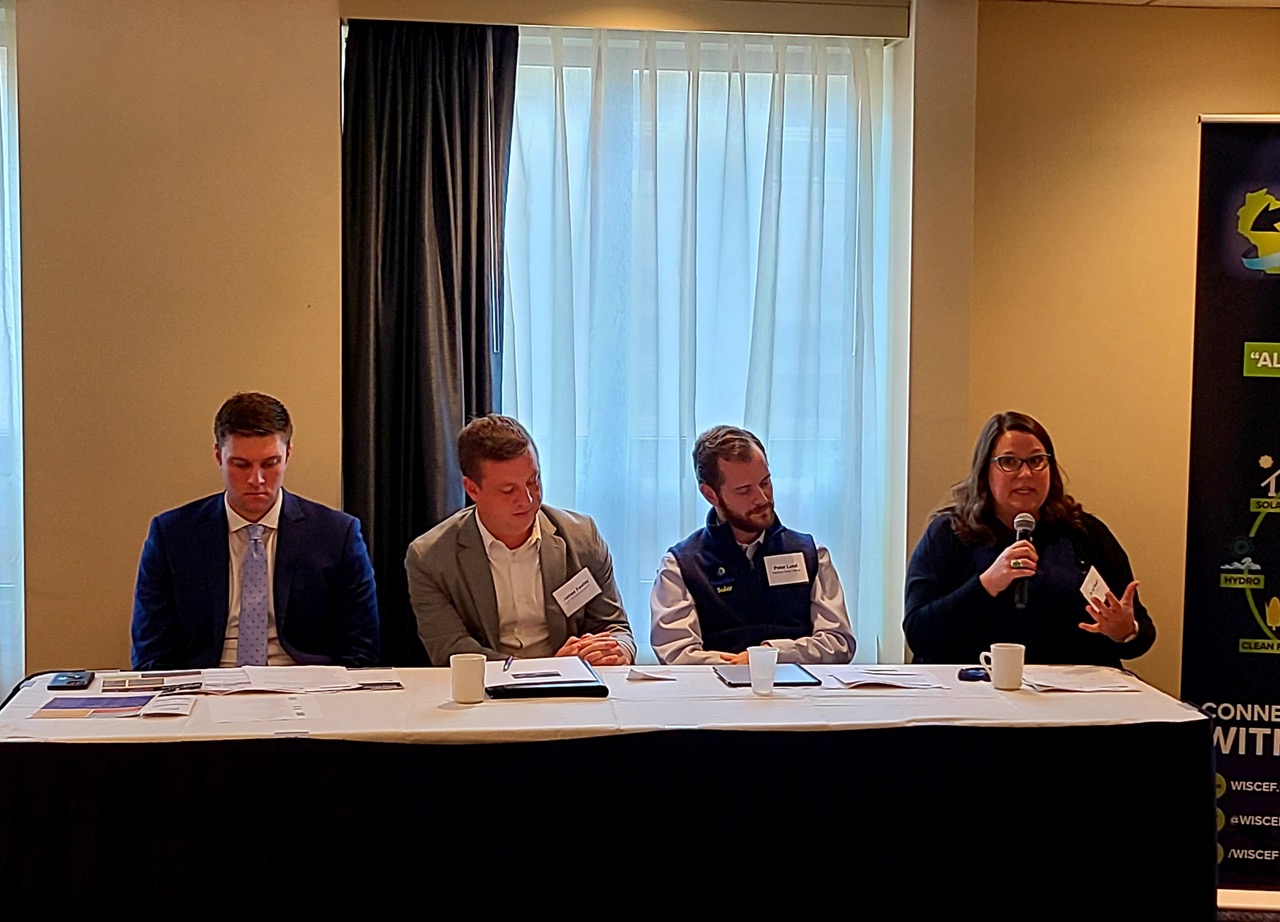
Issue briefing panelists, Left to right: Jason Mugnaini (Chief of Staff, State Senator Rob Cowles), James Fenley (SJL Government Affairs & Communications), Peter Lund (Financial Structuring Associate, Nautilus Solar Energy), and Amy Heart (Senior Director, Public Policy, Sunrun).
The first panel discussed two solar-related issues:
- Expanded Development of Community Solar – (SB 490 / AB 527 – Sen. Stroebel and Rep. Ramthun) This bill would authorize the development of non-utility owned community solar projects and provide access to the economic and environmental benefits of solar for those who can’t afford the full cost of a system, live in multi-family housing, or own property that is not suitable for solar.
- 3rd Party Financing/Leasing – (LRB 1550/1 Sen. Cowles and Rep. Cabral-Guevara) This legislation would clarify that 3rd party financing/leasing of renewable energy equipment is legal in Wisconsin, providing affordable financing options for people, businesses, municipalities, or not-for-profit entities who don’t have the resources to pay for solar on their own property.
The second panel, moderated by RENEW’s Jeremy Orr, Emerging Technology Program Manager, discussed electric vehicle issues such as Wisconsin’s recent Direct Electric Vehicle Sales legislation, SB 462 / AB 439 (Sen. Kooyenga and Rep. Neylon). Albert Gore, Policy and Business Development at Tesla, discussed how allowing manufacturers to sell electric vehicles directly to consumers creates greater access to the electric vehicle market, resulting in growth in the traditional dealership model. Read Jeremy Orr’s previous testimony on this issue here.
Likewise, Justin Ackley, Public Policy Manager at ChargePoint, spoke to the business clarity and consumer transparency that AB 588 / SB 573 (Sen. Cowles and Rep. VanderMeer) would provide, as it would allow non-utility-owned charging stations to charge by the kWh. Similar to a gas pump, where the price per gallon is displayed, kWh charging tells electric owners how much energy they’re paying for, regardless of how long it takes to charge their vehicle. The panel pointed out that while the main goal of this legislation is good, another section of it would create problems by prohibiting charging a fee if any of the electricity going through the EV charger comes from a non-utility source such as a solar+storage system.
Emerging technology allows EV chargers to be installed in areas, especially rural areas, that have inadequate grid infrastructure and can help limit costly spikes in energy “demand charges” for charging station owners. EnTech, a division of Faith Technologies based in Menasha, Wisconsin brought one of their portable solar+storage units to Capitol Square to demonstrate how the technology works and how flexible it can be. A similar system was set up at Bergstrom Ford in Neenah to help reduce the energy bills at their dealership. John Bergstrom, the owner of the dealership, told the story of why he worked with Faith Technologies to install the system in this podcast.
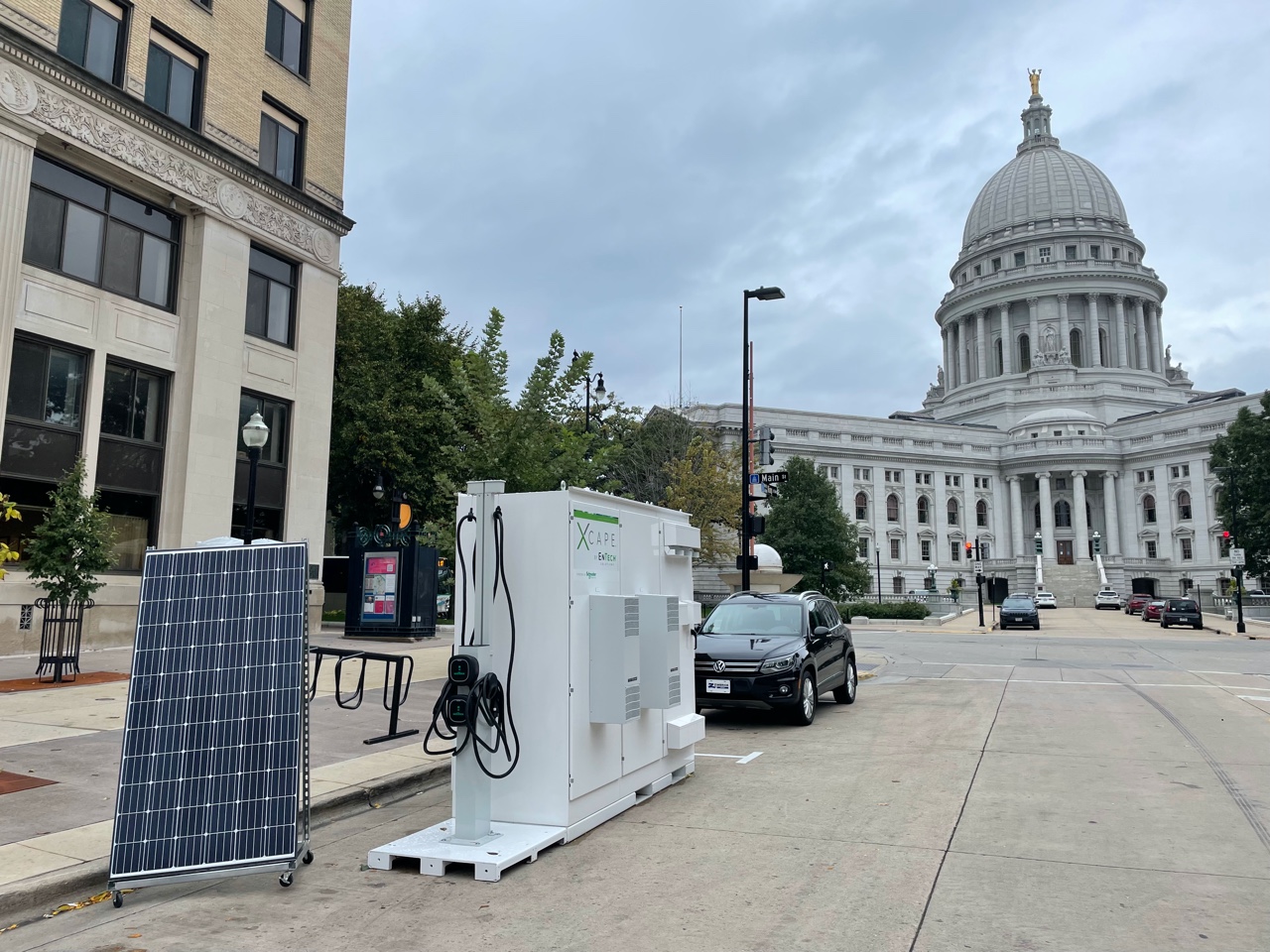
The panel closed the session by discussing two other bills recently introduced by Sen. Rob Cowles:
- $10 million in VW Settlement Funds for EV Charging Station Grants – (LRB-0254/1 Sen. Cowles and Rep. VanderMeer) Grants from these funds would be used to install electric vehicle charging stations at key locations throughout Wisconsin.
- Energy Storage Sales Tax Exemption – (LRB-1513/1) – Sen. Cowles and Rep. Duchow) This legislation would clarify that battery storage devices installed as part of a renewable energy system should be included in the sales tax exemption that already exists for renewable energy system equipment.
The 75 registered attendees made an impact by taking time out of their busy lives and getting involved in the political process. None of these issues will be easy to pass. In fact, most of them face significant opposition from powerful forces. But working together and building coalitions with pro-renewable energy friends helps get important legislation like this adopted.
If you would like to learn what you can do to help as well, contact Jim Boullion, Director of Government Relations at jim@renewwisconsin.org.






 Governor Evers and the Project Developer, Eric Udelhofen, from OneEnergy Renewables at the Ribbon Cutting Ceremony for the Strobus Solar project.
Governor Evers and the Project Developer, Eric Udelhofen, from OneEnergy Renewables at the Ribbon Cutting Ceremony for the Strobus Solar project. O’Brien Solar Fields in the city of Fitchburg, Wisconsin.
O’Brien Solar Fields in the city of Fitchburg, Wisconsin. 


